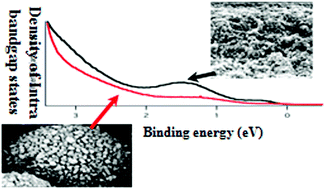Mesoporous TiO2 microbead electrodes for solid state dye-sensitized solar cells†
Abstract
Mesoporous TiO2 microbead films have been investigated as working electrodes for solid state dye sensitized solar cells and 3.5% efficiency was achieved for 4 micrometer thick films under 1 sun illumination. Compared to conventional mesoporous solar cells, microbead films have higher porosity, increased open circuit voltage, lower fill factor and current density, faster transport time and lower electron lifetime. Cross sectional scanning electron microscopy results show that the pore filling of a solid hole conductor (spiro-OMeTAD) inside the entire mesoporous bead film is very good even for 4 micrometer thick films. The high porosity of the microbead film allows good penetration of spiro in thick films, while its high surface area ensures good dye coverage. X-ray photoelectron spectroscopy data reveals a lower density of intra-bandgap trap states for microbead films compared to conventional mesoporous TiO2 films, which could be in part responsible for faster transport of electrons and higher voltage in microbead films. Optimization of microbead films for solid state dye sensitized solar cells can be an interesting possibility for highly efficient and relatively thick film solid state solar cells.


 Please wait while we load your content...
Please wait while we load your content...